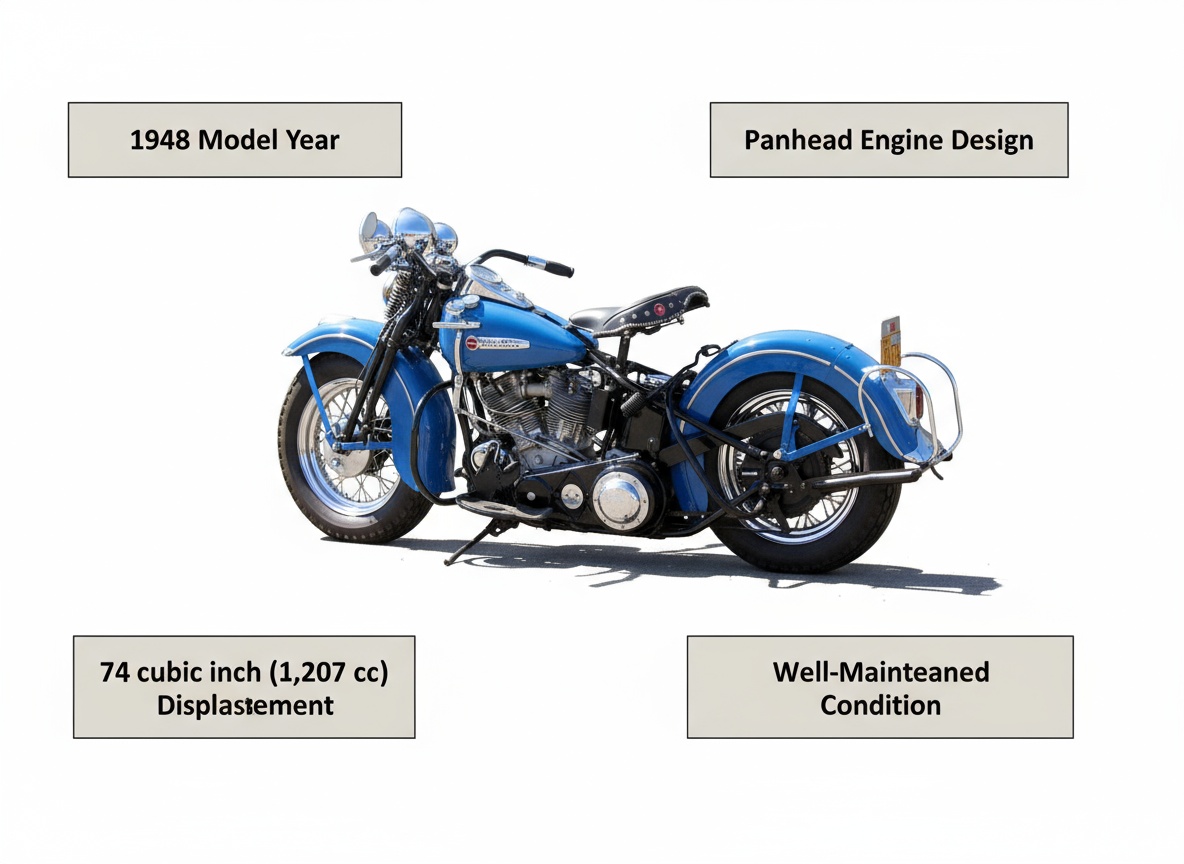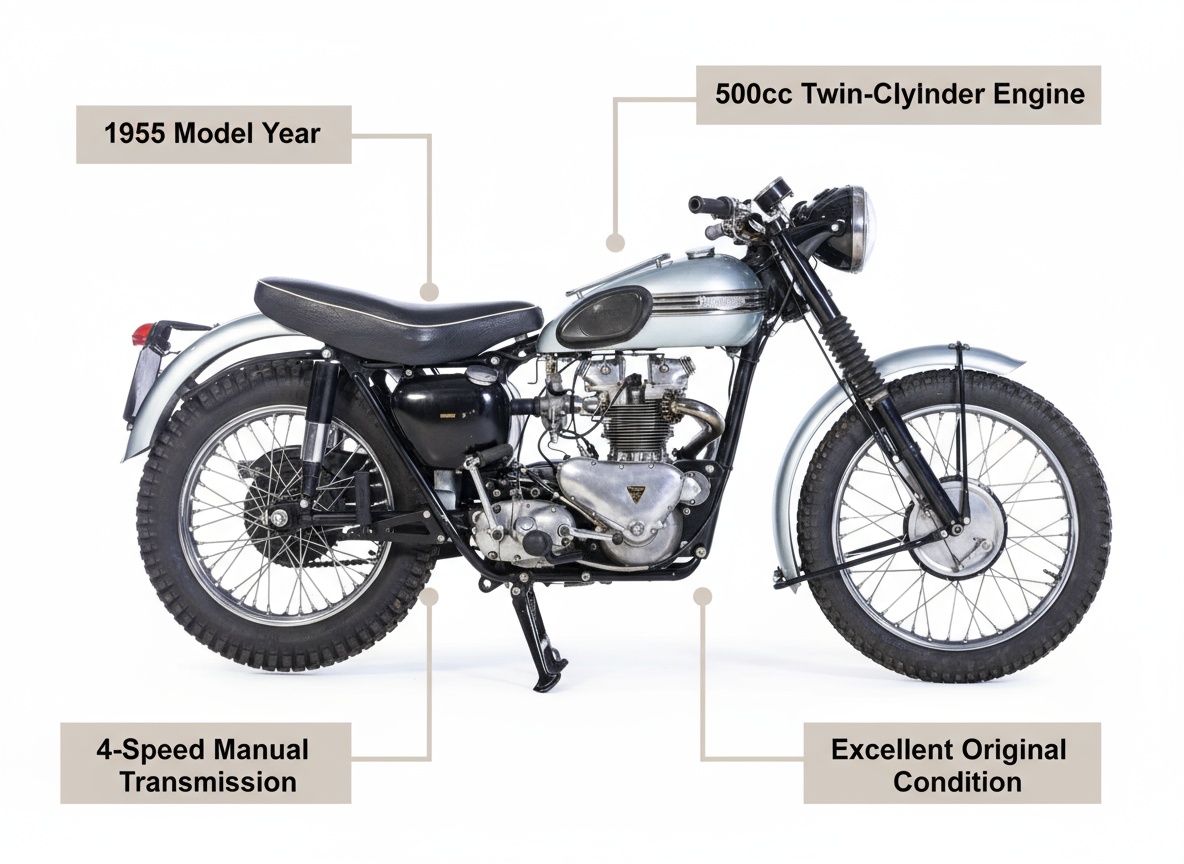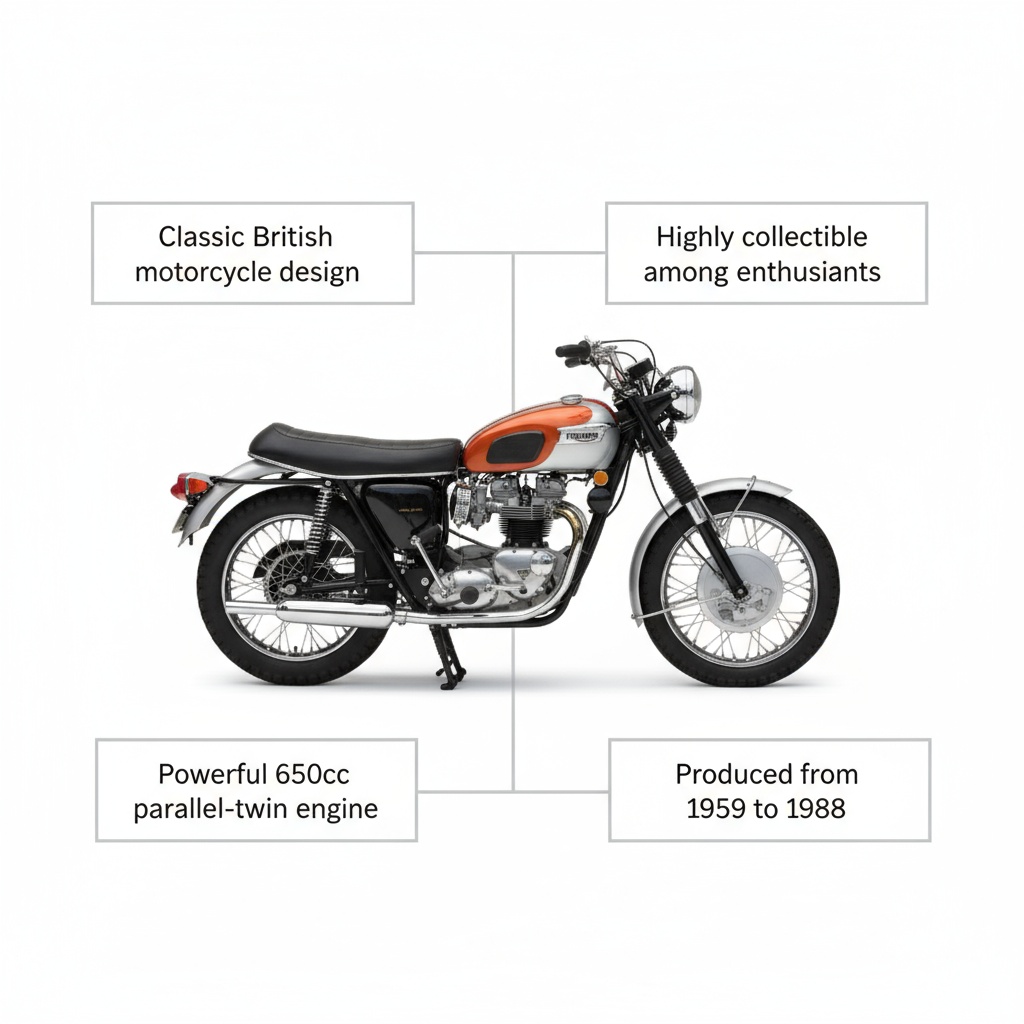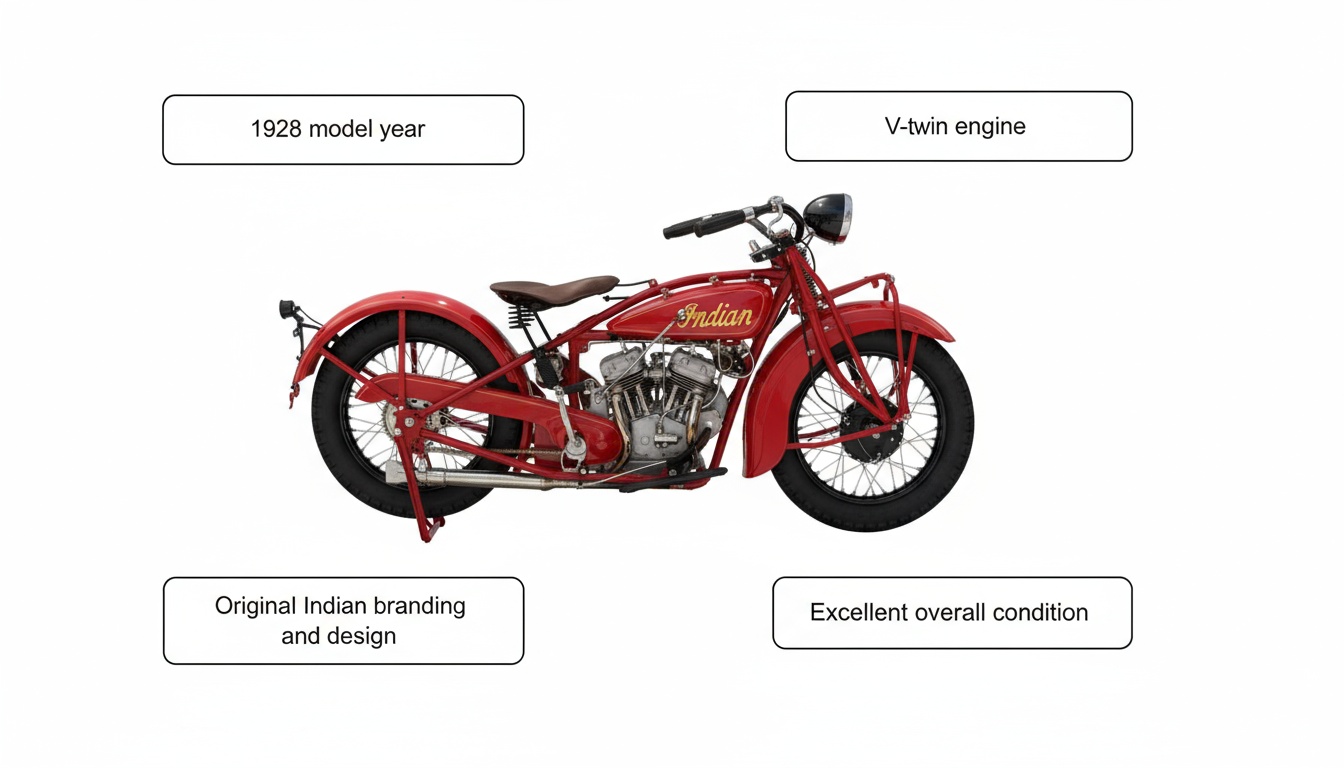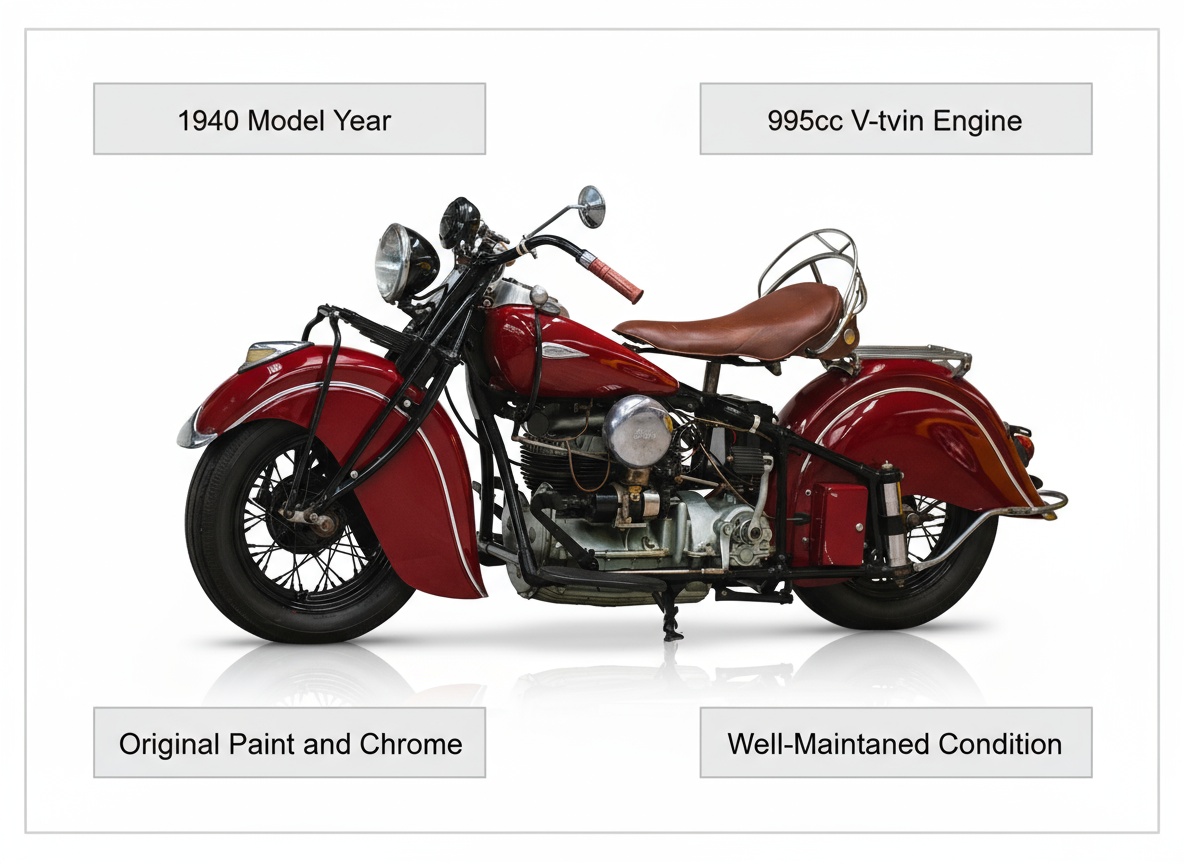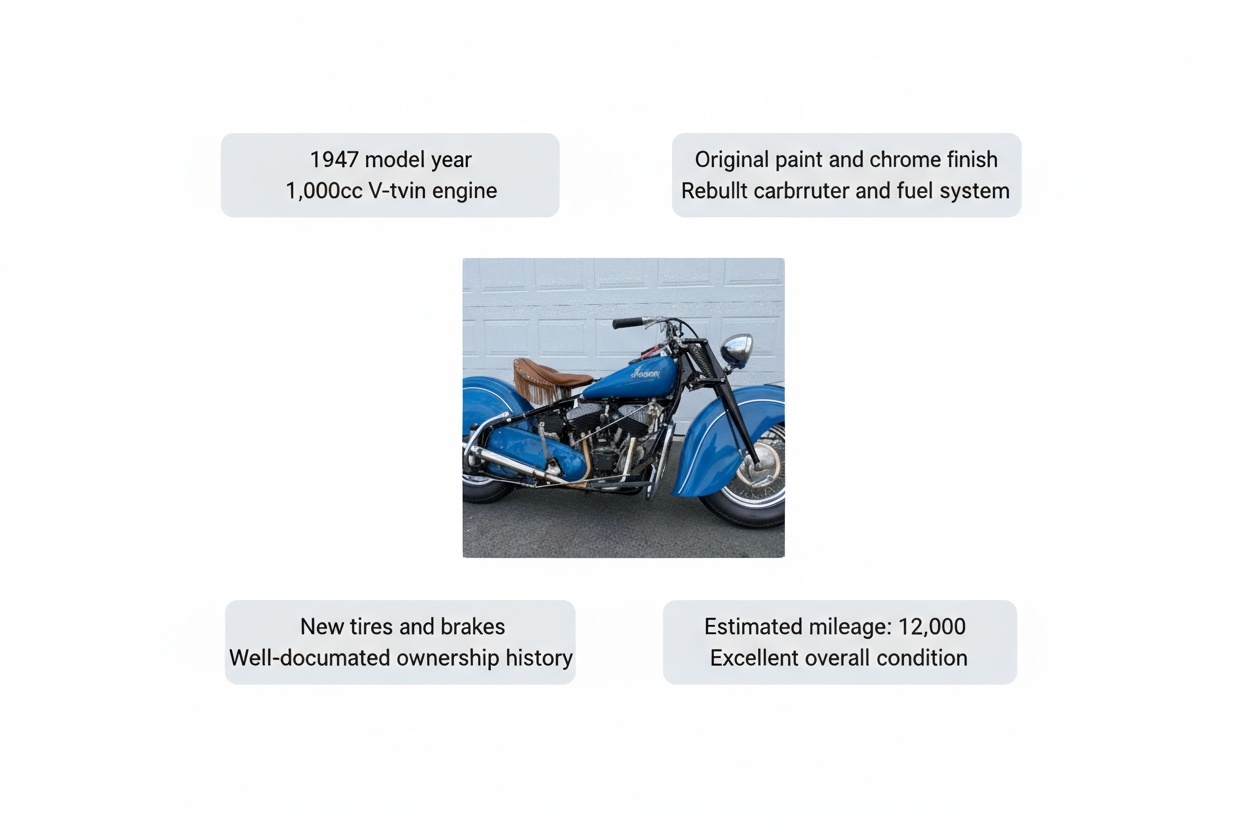<h2>Understanding the Value of Your 1948 Harley-Davidson Panhead</h2>
<p>When you're considering buying, selling, or insuring a 1948 Harley-Davidson Panhead, understanding its true market value is essential. This iconic postwar motorcycle represents a significant piece of American motorcycle history, and its worth depends on multiple interconnected factors. Whether you're a collector, enthusiast, or investor, knowing how to assess your bike's value will help you make informed decisions.</p>
<h2>What Is a 1948 Harley-Davidson Panhead?</h2>
<p>The 1948 Harley-Davidson Panhead marks the first year of Harley's revolutionary Panhead engine design. Named for its distinctive pan-shaped valve covers, this engine represented a major post-war update that combined classic Harley engineering with modern improvements. The 1948 model features a <strong>74 cubic inch (1,207 cc) V-Twin engine</strong>, <strong>4-speed transmission</strong>, and the timeless styling that defined American motorcycling for generations.</p>
<p>What makes a 1948 Panhead special is its historical significance. As the debut year of this iconic engine, first-year examples carry particular appeal among collectors who prize originality and period-correct components. The bike's classic chrome accents, vintage fuel tank design, and robust flathead V-Twin engine continue to attract enthusiasts worldwide.</p>
<div class="callout info"><p><strong>Did You Know?</strong></p>
<p>The Panhead's pan-shaped rocker covers gave the engine its name—a simple design feature that became one of Harley-Davidson's most recognizable design elements.</p></div>
<h2>How Much Is a 1948 Harley-Davidson Panhead Worth?</h2>
<p>The value of a 1948 Harley-Davidson Panhead varies considerably based on condition, originality, and restoration quality. Here's what you can typically expect across different market segments:</p>
<ul>
<li><strong>Project Bikes & Rough Restorations</strong>: $15,000–$25,000 for bikes requiring significant work or incomplete restorations</li>
<li><strong>Solid Running Examples</strong>: $25,000–$60,000 for well-maintained, partially restored, or reliable original bikes</li>
<li><strong>Concours-Level Originals & Expert Restorations</strong>: $60,000+ for museum-quality examples or rare configurations with complete documentation</li>
</ul>
<p>Regional demand, documentation quality, and the bike's specific history also influence pricing. Your location, buyer pool, and current market trends can shift values by 10–20%. For an exact figure tailored to your specific bike, a <strong>professional appraisal adhering to USPAP standards</strong> is your best option.</p>
<div class="callout tip"><p><strong>Pro Tip</strong></p>
<p>Before seeking an appraisal, gather your VIN, service records, photos from multiple angles, and any historical documentation. This preparation speeds up the appraisal process and provides appraisers with the context they need for accuracy.</p></div>
<h2>Key Factors That Influence 1948 Panhead Value</h2>
<p>Understanding what drives value helps you assess your own bike more accurately and understand appraiser recommendations.</p>
<h3>Originality and Matching Numbers</h3>
<p>One of the most significant factors collectors evaluate is whether the engine, frame, and major components match the original factory specifications. A <strong>matching-numbers 1948 Panhead</strong>—where the engine number corresponds to the frame and model year—typically commands a substantial premium over non-matching examples. This authenticity signals to buyers that the bike has not been heavily modified or rebuilt with mismatched parts.</p>
<p>If your bike has its original engine, transmission, and factory components, that documentation significantly increases its appeal and resale value. Even partial originality (original frame with replacement engine, for example) matters less than complete originality.</p>
<h3>Condition and Restoration Quality</h3>
<p>The overall condition of your 1948 Panhead directly impacts its market price:</p>
<ol>
<li><strong>Original Unrestored</strong>: Valuable if well-preserved, but may show wear and patina</li>
<li><strong>Partially Restored</strong>: Mixed original and new components; appeals to riders and builders</li>
<li><strong>Full Frame-Off Restoration</strong>: Complete disassembly and rebuild; typically commands the highest prices when executed with period-correct parts</li>
<li><strong>Custom or Modified</strong>: May appeal to a smaller buyer pool; value depends on quality and collector interest in that particular style</li>
</ol>
<p>Restoration quality matters significantly. A professionally executed restoration using correct-era components will outpace a DIY rebuild using modern parts or incorrect-period accessories.</p>
<h3>Provenance and Documentation</h3>
<p>Does your bike come with service records, original purchase documentation, or a clear ownership history? Bikes with <strong>documented provenance</strong>—especially those with interesting stories or notable previous owners—often sell for premiums over undocumented examples. Complete maintenance records demonstrate that the bike has been properly cared for, which reassures potential buyers.</p>
<h3>Rarity and Model Variations</h3>
<p>While all 1948 Panheads are historically significant, certain factory options or configurations are rarer than others. Special paint colors, unique accessories, or bikes delivered to specific markets can increase desirability. Understanding your bike's specific factory configuration helps appraisers determine if yours falls into a particularly sought-after category.</p>
<div class="callout note"><p><strong>Key Point</strong></p>
<p>Documentation is your friend. The more paperwork, photos, and service history you can provide, the stronger your position when selling or insuring your 1948 Panhead.</p></div>
<h2>How to Find the Value of Your 1948 Panhead</h2>
<p>If you're wondering how to accurately determine what your bike is worth, here's a practical roadmap:</p>
<h3>1. Document Everything</h3>
<p>Start by photographing your bike from multiple angles—close-ups of the engine, frame, VIN location, gauge cluster, and overall condition. Write down the VIN, engine number, and any notable features or modifications.</p>
<h3>2. Research Comparable Sales</h3>
<p>Check recent auction results, classified ads, and specialty motorcycle marketplaces for 1948 Panheads sold in the last 6–12 months. Note which bikes were similar to yours in condition, originality, and configuration. This gives you a ballpark range and helps you understand what the market is currently paying.</p>
<h3>3. Assess Your Bike's Condition</h3>
<p>Be honest about wear, rust, originality, and restoration quality. Compare your bike to the reference photos you've found. Is it in better or worse condition? Does it have matching numbers or documented service history?</p>
<h3>4. Consider Market Factors</h3>
<p>Vintage motorcycle demand fluctuates based on broader trends. Panhead popularity remains strong among collectors and builders, but regional interest can vary. A bike that commands premium prices in California might sell more slowly in areas with fewer vintage motorcycle enthusiasts.</p>
<h3>5. Seek Professional Appraisal</h3>
<p>For a definitive, legally defensible valuation, submit your information and photos to a credentialed appraiser. Professional appraisers hold certifications from respected organizations such as the <strong>American Society of Appraisers (ASA)</strong>, <strong>International Society of Appraisers (ISA)</strong>, and <strong>Appraisers Association of America (AAA)</strong>. They follow <strong>USPAP (Uniform Standards of Professional Appraisal Practice)</strong> guidelines, ensuring your appraisal is thorough, ethical, and compliant with industry standards.</p>
<p>An <a href="/types/motorcycle">online appraisal service</a> allows you to submit photos and documentation without requiring an in-person inspection, making the process convenient and efficient. For high-value bikes or those with complex histories, an <a href="/blog/appraising-classic-and-vintage-motorcycles-determining-collectible-bike-worth">in-person appraisal</a> may provide additional confidence.</p>
<div class="callout tip"><p><strong>Pro Tip</strong></p>
<p>Get your appraisal updated every few years to reflect market trends and maintain accurate insurance coverage. Vintage motorcycle values can shift based on collector demand and overall economic conditions.</p></div>
<h2>Why Professional Appraisal Matters for Your 1948 Panhead</h2>
<p>Whether you're buying, selling, insuring, or managing an estate that includes a 1948 Harley-Davidson Panhead, a professional appraisal provides several critical benefits:</p>
<h3>For Insurance Purposes</h3>
<p>Vintage motorcycles require specialized insurance coverage that reflects their true replacement value. Standard auto insurance undervalues classic bikes. A USPAP-compliant appraisal documents your bike's value and condition, helping your insurance agent provide appropriate coverage and ensuring you're properly protected.</p>
<h3>For Sales and Purchases</h3>
<p>When buying or selling, a credible appraisal removes ambiguity from negotiations. Sellers can justify their asking price with professional documentation, while buyers gain confidence that they're paying fair market value. An independent appraisal often accelerates transactions and builds trust between parties.</p>
<h3>For Estate Planning and Taxation</h3>
<p>If a 1948 Panhead is part of an estate, a professional appraisal establishes fair market value for tax and distribution purposes. This documentation protects heirs and ensures compliance with estate planning requirements.</p>
<h3>For Loan or Financing Purposes</h3>
<p>Some lenders require appraisals for collateral valuation when financing vintage vehicle purchases or using vehicles as collateral.</p>
<p>Appraisers assigned through <a href="/types/motorcycle">AppraiseItNow</a> hold credentials from organizations like the <strong>American Society of Appraisers</strong>, <strong>International Society of Appraisers</strong>, and <strong>Appraisers Association of America</strong>. They understand the nuances of vintage <a href="/blog/appraising-classic-and-vintage-motorcycles-determining-collectible-bike-worth">motorcycle appraisals</a> and deliver reports that meet the highest professional standards.</p>
<h2>Getting Started with Your 1948 Panhead Appraisal</h2>
<p>The appraisal process is straightforward and convenient. Here's what to expect:</p>
<ol>
<li><strong>Submit Your Information</strong>: Provide details about your 1948 Panhead—model year, VIN, condition, any recent work, and photos from multiple angles</li>
<li><strong>Appraiser Assignment</strong>: A credentialed specialist in vintage motorcycles reviews your submission</li>
<li><strong>Valuation Process</strong>: The appraiser researches comparable sales, evaluates condition, and considers market factors specific to 1948 Panheads</li>
<li><strong>Professional Report</strong>: You receive a detailed, USPAP-compliant appraisal report documenting the bike's value and the methodology used</li>
</ol>
<p>The entire process can be completed online without requiring an office visit, making it convenient for collectors and owners nationwide. For <a href="/blog/appraising-classic-and-vintage-motorcycles-determining-collectible-bike-worth">complex vintage motorcycles or high-value restorations</a>, in-person appraisals are also available.</p>
<div class="callout tip"><p><strong>Pro Tip</strong></p>
<p>When submitting photos for appraisal, include close-ups of the engine, VIN plate, frame number, gauge cluster, and any visible restoration work or wear. Clear documentation helps appraisers work efficiently and provide the most accurate valuation.</p></div>
<h2>The Bottom Line: Protecting Your Investment</h2>
<p>A 1948 Harley-Davidson Panhead is far more than a motorcycle—it's a piece of American automotive history with genuine collector value. Whether your bike is a museum-quality original, a well-maintained rider, or a work-in-progress restoration, understanding its true market value is essential for making smart ownership decisions.</p>
<p>Condition, originality, provenance, and matching numbers all influence what your 1948 Panhead is worth. By documenting your bike thoroughly, researching comparable sales, and seeking a professional appraisal from a credentialed specialist, you gain the clarity and confidence needed to buy, sell, insure, or manage your investment effectively.</p>
<p>Ready to discover your 1948 Panhead's true value? A professional appraiser stands ready to deliver a comprehensive, USPAP-compliant valuation that you can rely on.</p>
<div class="callout note"><p><strong>Key Takeaway</strong></p>
<p>Getting a professional appraisal helps you make informed decisions backed by certified experts who understand the 1948 Panhead market and can document your bike's value with precision and credibility.</p></div>

